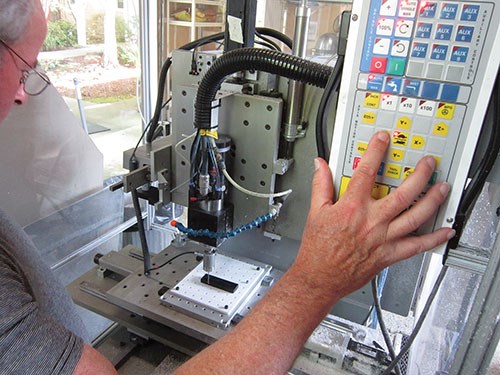Retired Engineer Turns Machinist
The industrial benchtop CNC mill that Dan Rosenthal installed in his garage is no toy.
Share






The industrial benchtop CNC mill that Dan Rosenthal installed in his garage is no toy. It has a range of optional features, including a 10-station ATC, 60,000-rpm spindle, toolsetting probe, touch-trigger probe and fourth-axis rotary table (not installed in this photo).
On one hand, this story, which appears in Modern Machine Shop’s June 2014 issue, is not the normal type of feature article we run. On the other hand, it most certainly is.
The story describes how Dan Rosenthal, a retired engineer who had no machining experience, is learning to become a good machinist. He’s largely a hobby machinist working out of his garage, which is why this story is atypical for our magazine. However, he has one customer for whom he produces prototype parts. In fact, that customer is sending him increasingly difficult work, which is what has driven him to become more deft at machining.
With that said, as you read the article, you’ll find that it’s remarkably similar to other articles we’ve written that describe how production shops have leveraged technology in some way to become more effective at machining. Dan’s story is interesting in that it demonstrates how new machining technology—CAM in particular—is becoming more capable and easier to pick up and apply. And while his current goals might be different than that of a production-oriented shop, those shops can just as readily apply new technology in the same way not only to be more successful, but to grow the talent level of their existing workforce and bring new shopfloor hires up to speed more quickly. This is pretty much what Dan is doing for himself.
Related Content
-
Large-Format Machining With Small Cutting Tools and Dynamic Motion
Napoleon Machine, a defense contractor that provides parts for the M1 Abrams tank, recently took advantage of a CAM feature that allowed the company to streamline its cutting strategies and program offline. Here’s how the shop cut cycle times nearly in half with its large-format five-axis machining operations.
-
Blueprints to Chips: CAD/CAM Tips and Tricks
This collection of articles delves into the latest CAD/CAM innovations, from AI-driven automation and optimized tool paths to the impact of digital twins and system requirements.
-
Cutting Part Programming Times Through AI
CAM Assist cuts repetition from part programming — early users say it cuts tribal knowledge and could be a useful tool for training new programmers.













